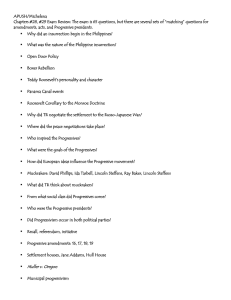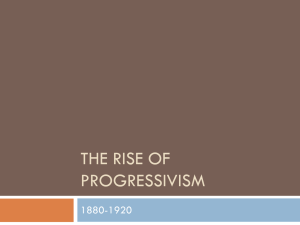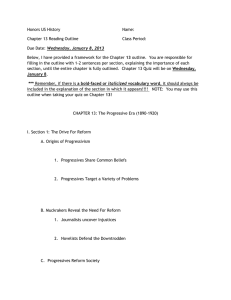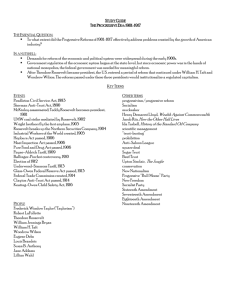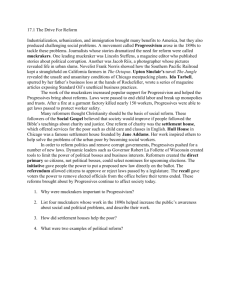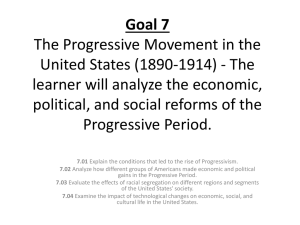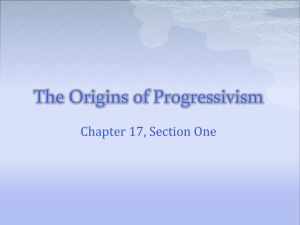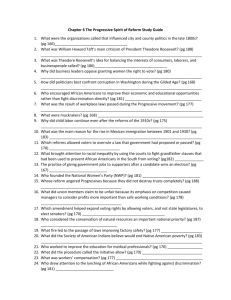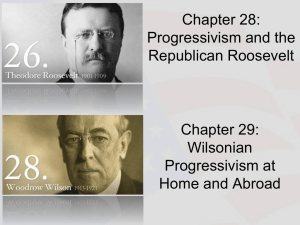Progressive Era Study Guide: Chapter 20 Summary
advertisement
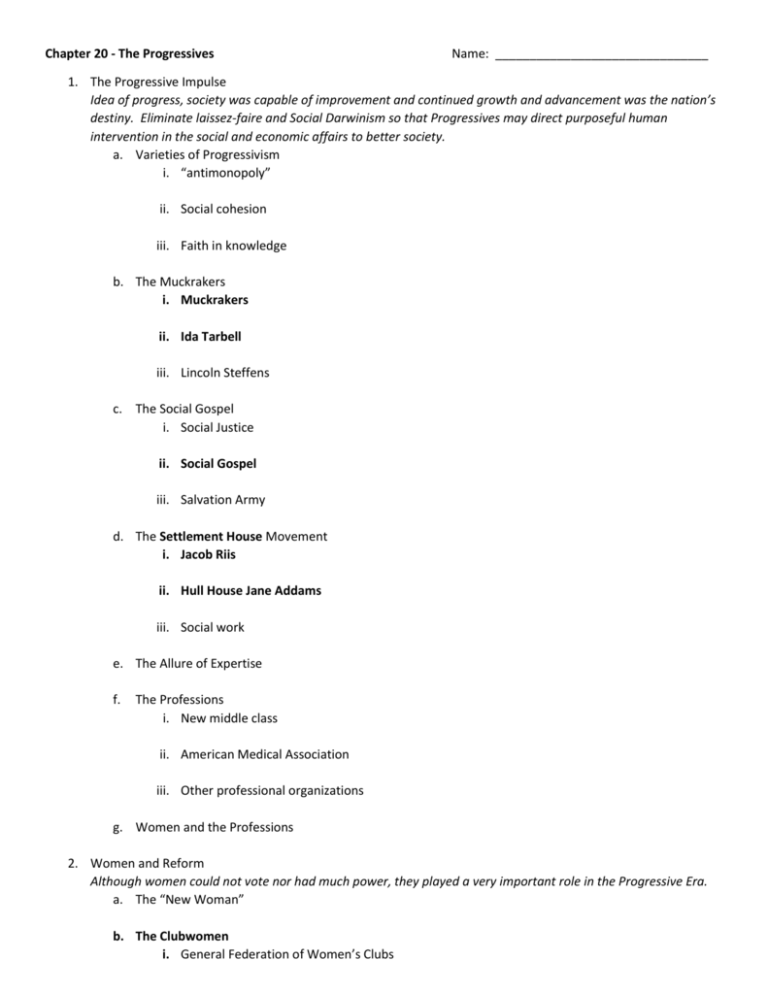
Chapter 20 - The Progressives Name: _______________________________ 1. The Progressive Impulse Idea of progress, society was capable of improvement and continued growth and advancement was the nation’s destiny. Eliminate laissez-faire and Social Darwinism so that Progressives may direct purposeful human intervention in the social and economic affairs to better society. a. Varieties of Progressivism i. “antimonopoly” ii. Social cohesion iii. Faith in knowledge b. The Muckrakers i. Muckrakers ii. Ida Tarbell iii. Lincoln Steffens c. The Social Gospel i. Social Justice ii. Social Gospel iii. Salvation Army d. The Settlement House Movement i. Jacob Riis ii. Hull House Jane Addams iii. Social work e. The Allure of Expertise f. The Professions i. New middle class ii. American Medical Association iii. Other professional organizations g. Women and the Professions 2. Women and Reform Although women could not vote nor had much power, they played a very important role in the Progressive Era. a. The “New Woman” b. The Clubwomen i. General Federation of Women’s Clubs ii. Uncontroversial iii. Passage of state and federal laws c. Women Suffrage i. Antisuffrage movement ii. National American Woman Suffrage Association (NAWSA) iii. Nineteenth Amendment 3. The Assault on the Parties Progressives believed to reform society the government must be reformed first. a. Early Attacks i. Secret ballot b. Municipal Reform c. New Forms of Governance i. Commission Plan ii. City-Manager Plan d. Statehouse Progressivism i. Initiative ii. Referendum iii. Direct primary iv. Recall v. Lobbying & campaign contributions vi. Robert La Follette e. Parties and Interest Groups 4. Sources of Progressive Reform a. Labor, The Machine, and Reform i. Tammany Hall ii. Triangle Shirtwaist Fire b. Western Progressives c. African Americans and Reform i. Booker T Washington ii. WEB DuBois iii. Niagara Movement iv. NAACP v. Grandfather clause vi. Lynching & Ida Wells 5. Crusade for Social Order and Reform a. The Temperance Crusade i. Temperance ii. Eighteenth Amendment b. Immigration Restriction i. Eugenics ii. Dillingham Report 6. Challenging the Capitalist Order a. The Dream of Socialism i. Socialist Party of America Eugene V Debs ii. Industrial Workers of the World (IWW) – “wobblies” iii. WWI & the demise of socialism b. Decentralization and Regulation i. Louis Brandeis ii. “good trusts” and “bad trusts” 7. Theodore Roosevelt and the Modern Presidency a. The Accidental President b. Government, Capital, and Labor i. Department of Commerce and Labor ii. Northern Securities Company iii. 1902 Coal Strike c. The “Square Deal” i. Hepburn Railroad Regulation Act 1906 ii. Pure Food and Drug Act iii. Meat Inspection Act d. Roosevelt and Conservation i. Gifford Pinchot – National Forrest Service ii. Newlands Act e. Roosevelt and Preservation f. The Hetch Hetchy Controversy g. The Panic of 1907 & JP Morgan 8. The Troubled Succession William Howard Taft a. Taft and the Progressives i. Payne-Aldrich Tariff ii. Ballinger-Pinchot Dispute b. The Return of Roosevelt i. “New Nationalism” c. Spreading Insurgency d. Roosevelt versus Taft i. Republican Convention ii. “Bull Moose” or Progressive Party 9. Woodrow Wilson and the New Freedom a. Woodrow Wilson i. “New Freedom” ii. Election of 1912 b. The Scholar as President i. Underwood-Simmons Tariff ii. Sixteenth Amendment iii. Federal Reserve Act iv. Federal Trade Commission Act v. Clayton Anti-Trust Act c. Retreat and Advance
